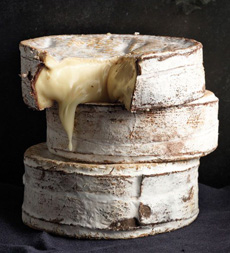Cheese Glossary: A Glossary Of The Different Cheese TypesPage 2: Cheese Glossary B This is Page 2 of an 12-page article. Click on the red links below to visit other pages. This glossary is protected by copyright and cannot be reproduced in whole or part. You are welcome to link to it.
|
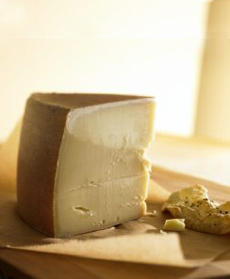 Gruyère is an example of a brushed rind cheese. Photo courtesy Wisconsin Milk Marketing Board. |
|
| BANDAGE-WRAPPED CHEESES
A cheese that has been wrapped in cheesecloth, which is sealed with a fat based product like lard. It is an preservation alternative to wax, and is used on fine Cheddars. After the curds are removed from the press, the pressed cheese is wrapped with a sterile cloth “bandage.” Bandaging produces a better-flavored cheese due to the molds that form around the bandage. It also
|
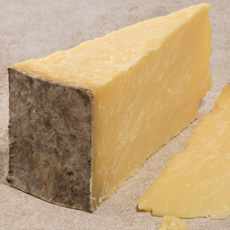 Bandage-wrapped Montgomery"™s Cheddar from England, at Murray"™s Cheese. |
|
| BARK-WRAPPED CHEESE
Wrapping cheese in spruce bark is an old world technique. The most familiar of those classics is Vacherin Mont d"™Or from Switzerland. Wrapping serves two key purposes: (1) It girdles very soft, spoonable, oozy cheeses like Winnimere. (2) adds a smoky, woodsy or verdant flavor and aroma to the cheese. The bark strips are boiled to |
||
| BARNYARDY
A term often used to describe a cheese’s aroma and sometimes its taste: Aged goat cheeses are often barnyardy. It is considered a positive characteristic of the cheese.
|
||
| BLEU CHEESE
Bleu is the French spelling of blue. See blue mold cheeses. |
||
| BLOOMY RIND CHEESE
Bloomy rind cheeses have soft, often fuzzy, edible rinds that are a result of the introduction of molds like Penicillium candidum. They are known for the white color and mushroomy flavor of the rind. The two best-known examples are Brie and Camembert. Bloomy rind cheeses are generally aged for two weeks, which produces a mild flavor and subtle aroma. Learn the words that describe bloomy cheese. |
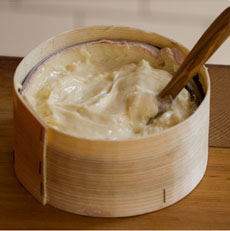
|
|
| BLUE CHEESE, BLUE MOLD or BLUE VEINED CHEESES Perhaps the most distinctive class of cheese, because it is easily identifiable by the mold that creates the blue or blue-green streaks in the paste. Penicillium roqueforti, Penicillium gorgonzola or Penicillium glaucum sporesare injected into the cheese, which provide the blue-green colors and piquant flavor (although some blues are mild). The mold will not thrive until oxygen comes into contact with it, so the cheeses are pierced with pins. Then air is injected, which allows the mold to flourish and causes the cheeses to develop a very high acid content and crumb-like texture. Blues are typically aged for 90 days, which enables them to become more solid. Blues can range from high-moisture to firm and well-aged; the common thread is the addition of the mold spores into the milk during the cheesemaking process. Blue cheeses are found in all categories of cheese with the exception of fresh cheeses, since the mold needs time to develop. Roquefort, Stilton and Gorgonzola are the big three, with Danish Blue the fourth best-known blue.
|
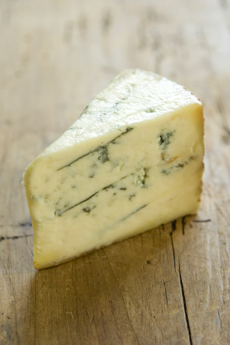 This creamy Stilton, imported from England, is available at Whole Foods Market. |
|
| The legend of blue cheese is that a cheesemaker accidentally left a piece of rye bread in the cheese caves. He returned several weeks later to find that the mold covering the bread had attached itself to the cheese. Today, Roquefort is still inoculated with the spores of moldy rye bread. Learn the words that describe blue cheese and learn more about blue cheese.
|
||
| BREBIS
The French term for a cheese made from sheep’s milk.
|
||
| BRILLAT SAVARIN One of the most famous triple-crème cheeses, from France (photo at right). It is a great pairing with Champagne.
|
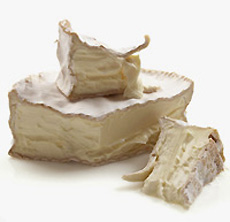 Brillat Savarin. Photo courtesy iGourmet.com. |
|
| BÛCHE
The French word for log, a popular shape for goat cheese (chèvre), shown in the photo at right. It is made in whole logs (generally 8 ounces) and half logs. Pronounced as a cross between “boosh” and “beesh.”
|
||
| BUFFALO MOZZARELLA
Mozzarella cheese made from the milk of the water buffalo, rather than cow’s milk. See mozzarella di bufala
|
 Pink peppercorn log of fresh chèvre from Vermont Creamery. Read our review. |
|
| BURRATA A ball of mozzarella di bufala, filled with scraps of mozzarella and fresh cream, and wrapped in the leaves of asphodel, which indicate the cheese’s freshness. A specialty of the Murgia area of Puglia, Italy, it can be served as mozzarella is served, although the creamy insides beg for fresh, crusty bread or crostini. With a very short shelf life, it is flown to specialty cheese shops in the U.S., but can be hard to find. Some U.S. cheesemakers have begun to make it, including Mozzarella Company, which makes the burrata shown in the photo. More about burrata cheese.
|
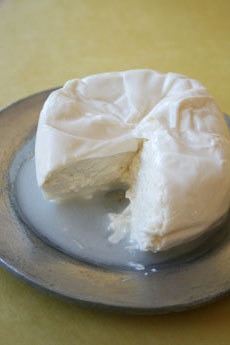 Burrata: mozzarella on the outside, a ricotta-like filling on the inside. Photo by Hannah Kaminsky | THE NIBBLE. |
|
| BRIE & CAMEMBERT These popular cheeses are essentially the same cheese (the recipe is the same), differing only in the locales in which they are made and the sizes in which they are created: Camembert, named after the village in northwestern France where it is made, is made in 4.5-inch wheels, while Brie is made in much larger formats, 11 to 11.8 inches (28 to 30 cm). The paste is straw-colored and flavor is buttery and mushroomy. The soft, bloomy rind, made of Penicillium candidum, is fully edible. As a result of the terroir, and of the faster evaporation in a smaller-size cheese, there are nuances of flavor difference. Read our full article on the difference between Brie and Camembert. Brie, named for the province in northern France where it originated, is made from raw cow’s milk cheese. While it is made in many locales today, only two Bries are AOC-protected: Brie de Meaux and Brie de Melun. The Melun Brie has very ancient origins—manuscripts suggest that it predates the Roman invasion. At the Vienna Congress of 1815, Brie was declared the “king of cheeses” during a diplomatic banquet; it has also been called the “queen of cheeses,” and fights Roquefort and Parmigiano-Reggiano for the king’s crown.
|
 This Brie is not yet a point, since the paste is hard and doesn’t bulge. Photo courtesy iGourmet. |
|
| BRINE CURED
Many types of cheese are washed with, or submerged into, a brine bath as part of the cheese making process. The brining solution provides cheese with a slightly salty flavor and helps to limit the growth of unwanted bacteria that can produce a foul taste in the cheese (in other stages of the cheese making process, beneficial bacteria are necessary for producing the positive, character-giving qualities of the cheese). Appenzeller, Feta Gouda and Parmigiano-Reggiano are examples of brine-cured cheeses.
|
||
| BRUSHED RIND CHEESE Certain types of natural rind cheeses, both cooked and uncooked varieties, have their rinds brushed during the period they spend ripening. This brushing, done by hand or machine, helps the interior of the cheese to keep moist during the ripening period. It also has an effect on the final flavor of the cheese: Etivaz, an AOC-protected Swiss cheese shown in the photo at right, is brushed with salt. Continue To Page 3: Terms Beginning With C
|
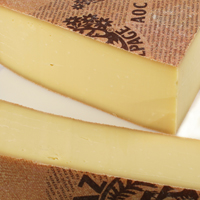 Etivaz. Photo courtesy iGourmet.com. |
|
Last Updated May 2018
© Copyright 2005-2025 Lifestyle Direct, Inc. All rights reserved. All images are copyrighted to their respective owners.
